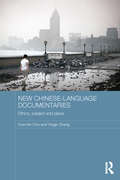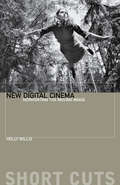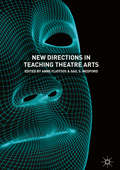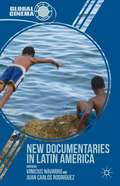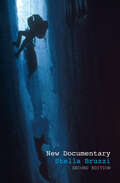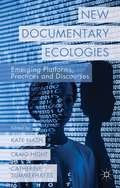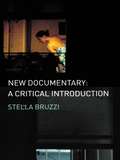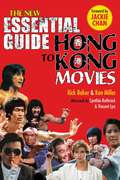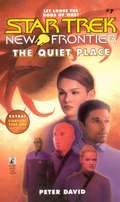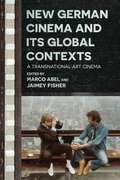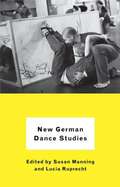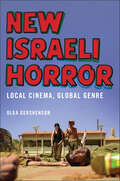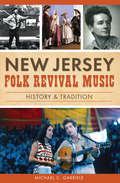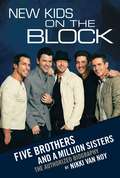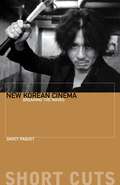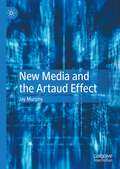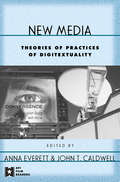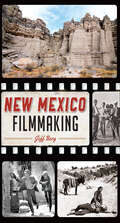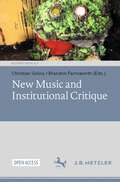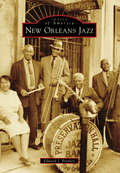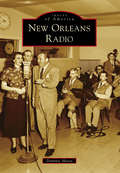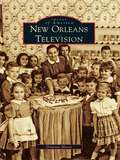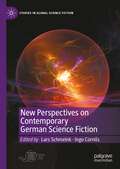- Table View
- List View
New Chinese-Language Documentaries: Ethics, Subject and Place (Media, Culture and Social Change in Asia)
by Yingjin Zhang Kuei-fen ChiuDocumentary filmmaking is one of the most vibrant areas of media activity in the Chinese world, with many independent filmmakers producing documentaries that deal with a range of sensitive socio-political problems, bringing to their work a strongly ethical approach. This book identifies notable similarities and crucial differences between new Chinese-language documentaries in mainland China and Taiwan. It outlines how documentary filmmaking has developed, contrasts independent documentaries with dominant official state productions, considers how independent documentary filmmakers go about their work, including the work of exhibiting their films and connecting with audiences, and discusses the content of their documentaries, showing how the filmmakers portray a wide range of subject matter regarding places and people, and how they deal with particular issues including the underprivileged, migrants and women in an ethical way. Throughout the book demonstrates how successful Chinese-language independent documentary filmmaking is, with many appearances at international film festivals and a growing number of award-winning titles.
New Digital Cinema: Reinventing the Moving Image (Short Cuts)
by Holly WillisThis introduction to contemporary digital cinema tracks its intersection with video art, music video, animation, print design and live club events to create an avant-garde for the new millennium. It begins by investigating digital cinema and its contribution to innovations in the feature-film format, examining animation and live-action hybrids, the gritty aesthetic of the Dogme 95 filmmakers, the explosions of frames within frames and the evolution of the ‘ambient narrative’ film. This study then looks at the creation of new genres and moving-image experiences as what we know as ‘cinema’ enters new venues and formats.
New Directions in Teaching Theatre Arts
by Anne Fliotsos Gail S. MedfordThis book reflects the changes in technology and educational trends (cross-disciplinary learning, entrepreneurship, first-year learning programs, critical writing requirements, course assessment, among others) that have pushed theatre educators to innovate, question, and experiment with new teaching strategies. The text focuses upon a firm practice-based approach that also reflects research in the field, offering innovative and proven methods that theatre educators may use to actively engage students and encourage student success. The sixteen essays in this volume are divided into five sections: Teaching with Digital Technology, Teaching in Response to Educational Trends, Teaching New Directions in Performance, Teaching Beyond the Traditional, and Teaching Collaboratively or Across Disciplines. Study of this book will provoke readers to question both teaching methods and curricula as they consider the ever-shifting arts landscape and the potential careers for theatre graduates.
New Documentaries in Latin America
by Vinicius Navarro Juan Carlos Rodr�guezExamining the vast breadth and diversity of contemporary documentary production, while also situating nonfiction film and video within the cultural, political, and socio-economic history of the region, this book addresses topics such as documentary aesthetics, indigenous media, and transnational filmmaking, among others.
New Documentary
by Stella BruzziPraise for New Documentary: 'It's refreshing to find a book that cuts through the tired old debates that have surrounded documentary film and television. It heralds a welcome new approach.' Sight and Sound 'Documentary practice changes so fast that books on the subject are often out of date before they are published. Bruzzi's achievement is to have understood the genre as an activity based on performance rather than observation. This is a fresh perspective which illuminates the fundamental shifts that will continue to take place in the genre as it enters its second century.' John Ellis, Professor of Media Arts, Royal Holloway, University of LondonNew Documentary provides a contemporary look at documentary and fresh and challenging ways of theorising the non-fiction film. As engaging as the original, this second edition features thorough updates to the existing chapters, as well as a brand new chapter on contemporary cinema release documentaries. This new edition includes: Contemporary films such as Capturing the Friedmans, Être et avoir, Farenheit 9/11, The Fog of War and Touching the Void as well as more canonical texts such as Hoop Dreams and Shoah Additional interviews with influential practitioners, such as director Michael Apted and producer Stephen Lambert A comprehensively revised discussion of modern observational documentary, including docusoaps, reality television and formatted documentaries The work of documentary filmmakers such as Nicholas Barker, Errol Morris, Nick Broomfield, Molly Dineen and Michael Moore and the work of Avant-Garde filmmakers such as Chris Marker and Patrick Keiller Gender identity, queer theory, performance, race and spectatorship. Bruzzi shows how theories of documentary filmmaking can be applied to contemporary texts and genres, and discusses the relationship between recent, innovative examples of the genre and the more established canon of documentary.
New Documentary Ecologies
by Kate Nash Craig Hight Catherine SummerhayesProviding a unique collection of perspectives on the persistence of documentary as a vital and dynamic media form within a digital world, New Documentary Ecologies traces this form through new opportunities of creating media, new platforms of distribution and new ways for audiences to engage with the real.
New Documentary: A Critical Introduction
by Stella BruzziNew Documentary: A Critical Introduction provides a comprehensive account of the last two decades of documentary filmmaking in Britain, the US and Europe. Stella Bruzzi's engaging textbook discusses key genres, filmmakers, and issues for the study of non-fiction film and television, including:* key texts such as the Zapruder film of Kennedy's assassination, Shoah, Hoop Dreams and Michael Apted's 7 Up series* documentary genres, from current affairs programming to 'fly on the wall' documentaries to 'reality tv' series* the work of documentary filmmakers such as Emile de Antonio, Fred Wiseman, Nick Broomfield, Molly Dineen and Paul Watson* the work of avant-garde filmmakers such as Chris Marker, Patrick Keiller, Peter Greenaway and Wim Wenders, whose films challenge conventions of documentary filmmaking* movies based on historical events, such as 'JFK' and 'Nixon'* faux documentaries such as This is Spinal Tap, Bob Roberts and Man Bites Dog* gender identity, queer theory, performance, 'race' and spectatorship.Bruzzi shows how theories of documentary filmmaking can be applied to contemporary texts and genres, and discusses the relationship between recent, innovative examples of the genre and the more established canon of documentary.
New Essential Guide to Hong Kong Movies
by Kenneth Miller Rick BakerExtensively revised and expanded, The New Essential Guide to Hong Kong Movies includes over 670 film reviews, a poster gallery, and a look at the key studios that made Hong Kong cinema so amazing, along with insights into the Hong Kong movie industry written by global superstar Jackie Chan and Hong Kong film stars Cynthia Rothrock, and Vincent Lyn. Rick Baker and Ken Miller have curated a huge selection of reviews of kung fu and swordplay films, gangster flicks, crime dramas, action, horror, fantasy, erotic, and assorted Category III films, sharing their love for these distinctive, kinetic, and sometimes utterly bizarre Hong Kong genre productions with an infectious enthusiasm.
New Frontier #7 The Quiet Place (Star Trek: The Next Generation #Bk.7)
by Peter DavidEver since the fall of the Thallonian Empire, Si Cwan has been searching for his younger sister, the only other survivor of the royal family. Now it seems his quest may be nearing its end. On the planet Montos a mysterious young woman, her past shrouded in secrecy, finds herself pursued both by the fanatical Redeemers and a vicious race of feral predators known only as the Dogs of War. All are after information regarding the true nature and location of the Quiet Place, a mystical realm celebrated in myth and legend. Is Riella indeed Si Cwan's long-lost sister? Before he can learn the truth, he and his companions - Mackenzie Calhoun, the scarred, alien captain recommended by Jean-Luc Picard; Commander Shelby, ambitious first officer and Calhoun's fomer lover; Dr Selar, the Vulcan physician formerly assigned to the Enterprise; Ops officer Robin Lefler, and the rest of the Excalibur's crew - must brave the unchecked savagery of the Dogs of War - and enter the terrifying heart of the Quiet Place.
New German Cinema and Its Global Contexts: A Transnational Art Cinema (Contemporary Approaches to Film and Media Studies)
by Barry Keith Grant Eric RentschlerRediscovering a momentous cinema movement, its canonization, and its recasting through global discourse. The last of the so-called new waves in film, New German Cinema of the 1970s and early 1980s represents much more than a national phenomenon; it impacted and was influenced by films from around the world. Filmmakers such as the famous troika of Rainer Werner Fassbinder, Werner Herzog, and Wim Wenders, as well as directors, such as Margarethe von Trotta, Helma Sanders-Brahms, and Helke Sander, and Volker Schlöndorff received much critical acclaim both in Germany and abroad. These directors, their films, and their often-infamous reputations constitute one of the most intriguing and consequential legacies of European cinema and world culture. In this groundbreaking view of New German Cinema through a global lens, editors Marco Abel and Jaimey Fisher approach these celebrated years of German art film from diverse and innovative perspectives. Contributors explore these films' transnational circuits of production, distribution, and exhibition, as well as how the films were made and received, thereby inviting us to reexamine the roots of what New German Cinema was and imagine what it might yet become.
New German Dance Studies
by Susan Manning Lucia RuprechtNew German Dance Studies offers fresh histories and theoretical inquiries that resonate across fields of the humanities. Sixteen essays range from eighteenth-century theater dance to popular contemporary dances in global circulation. In an exquisite trans-Atlantic dialogue that demonstrates the complexity and multilayered history of German dance, American and European scholars and artists elaborate on definitive performers and choreography, focusing on three major thematic areas: Weimar culture and its afterlife, the German Democratic Republic, and recent conceptual trends in theater dance. Contributors are Maaike Bleeker, Franz Anton Cramer, Kate Elswit, Susanne Franco, Susan Funkenstein, Jens Richard Giersdorf, Yvonne Hardt, Sabine Huschka, Claudia Jeschke, Marion Kant, Gabriele Klein, Karen Mozingo, Tresa Randall, Gerald Siegmund, and Christina Thurner.
New Israeli Horror: Local Cinema, Global Genre
by Olga GershensonBefore 2010, there were no Israeli horror films. Then distinctly Israeli serial killers, zombies, vampires, and ghosts invaded local screens. The next decade saw a blossoming of the genre by young Israeli filmmakers. New Israeli Horror is the first book to tell their story. Through in-depth analysis, engaging storytelling, and interviews with the filmmakers, Olga Gershenson explores their films from inception to reception. She shows how these films challenge traditional representations of Israel and its people, while also appealing to audiences around the world. Gershenson introduces an innovative conceptual framework of adaptation, which explains how filmmakers adapt global genre tropes to local reality. It illuminates the ways in which Israeli horror borrows and diverges from its international models. New Israeli Horror offers an exciting and original contribution to our understanding of both Israeli cinema and the horror genre. A companion website to this book is available at https://blogs.umass.edu/newisraelihorror/ (https://blogs.umass.edu/newisraelihorror/) Book trailer: https://youtu.be/oVJsD0QCORw (https://youtu.be/oVJsD0QCORw)
New Jersey Folk Revival Music: History & Tradition
by Michael C. GabrieleNew Jersey shaped folk revival music into an art form. The saga began with the bawdy tunes sung in colonial-era taverns and continued with the folk songs that echoed through the Pine Barrens. "Guitar Mania" became a phenomenon in the 1800s, and twentieth-century studio recordings in Camden were monumental. Performances by legendary artists like Woody Guthrie, Pete Seeger, Joan Baez and Bob Dylan spotlighted the state's folk revival movement and led to a flourishing community of folk organizations, festivals and open-mic nights at village coffeehouses. Author Michael Gabriele traces the evolution and living history of folk revival music in the Garden State and how it has changed the lives of people on stage and in the audience.
New Kids On The Block
by Scott NanceIn this introduction to the New Kids on the Block, you will learn where all the "kids" grew up, in Boston, how the band was formed, what the kids like to do when they are not on the road, and what their plans are for the future.
New Kids on the Block
by Nikki Van NoyJordan, Jon, Joe, Donnie, and Danny. They set the bar for every boy band that followed and changed the course of pop music forever. In the 1980s, for millions of young girls around the world, they were gods. But behind the scenes, they were just kids. In this authorized biography of the band, the New Kids tell it all to rock journalist Nikki Van Noy. From makeshift stages in Boston clubs to soldout shows at Madison Square Garden, through winning American Music Awards and selling 80 million records, the New Kids on the Block (NKOTB) were a rite of passage and a touchstone of youthful memories. Scoring platinum albums, and with a series of sold-out international tours, NKOTB blazed through North and South America, Europe, Australia, and Asia, leaving throngs of screaming teen and tween girls in their wake. But after a few heady years, the guys (and their fans) grew up, and moved on. The New Kids disbanded in 1994 and, for nearly fifteen years, there was every reason to believe that the NKOTB phenomenon was over once and for all. But then an unexpected thing happened. The band (and their fans) got a second chance to relive their youth when NKOTB reunited in 2008. And they realized that this band has something special--an unbreakable bond with their fans and with each other that has only strengthened with the passage of time. Today, fans both old and new celebrate the band's triumphant comeback with sold-out concerts, cruises, and top-selling albums. And this time, Jordan, Jon, Joe, Donnie, and Danny are enjoying it all right alongside them. An intimate, all-access backstage pass to everything New Kids on the Block, from their meteoric rise to fame Nikki Van Noy talks directly to those loyal fans, as well as to all five band members and their families, weaving their stories together in this no-holds-barred chronicle. With frankness and honesty, each New Kid recalls nearly thirty years of experience with the group, both on and off the stage. Like a time machine, this book will take you right back--giving you an inside look at the New Kids like you've never seen them before. An intimate, all-access backstage pass to everything New Kids on the Block, from their meteoric rise to fame in the 1980s to the band's breakup in the 1990s-- and their triumphant comeback today "We're siting there, and all of a sudden Jordan said, 'You know we're gonna be famous, right? We're gonna be famous.' And he was right." --Joe "All that stuf f we never experienced in college, we experienced on the road, just the five of us." --Jon "There's just no words to describe it. I guess the only thing similar is a Super Bowl quarterback winning it for his hometown." --Danny "It's amazing. It's almost like going through life and then geting another chance at life, knowing what you know now." --Jordan "My dad said, 'I'll tell you what--if you ever make it big and you come home and you've changed, I'm gonna kick your ass.' That always rang in my head." --Donnie
New Korean Cinema: Breaking the Waves
by Darcy PaquetNew Korean Cinema charts the dramatic transformation of South Korea's film industry from the democratization movement of the late 1980s to the 2000s new generation of directors. The author considers such issues as government censorship, the market's embrace of Hollywood films, and the social changes which led to the diversification and surprising commercial strength of contemporary Korean films. Directors such as Hong Sang-soo, Kim Ki-duk, Park Chan-wook, and Bong Joon-ho are studied within their historical context together with a range of films including Sopyonje (1993), Peppermint Candy (1999), Oldboy (2003), and The Host (2006).
New Korean Cinema: Breaking the Waves
by Darcy PaquetNew Korean Cinema charts the dramatic transformation of South Korea's film industry from the democratization movement of the late 1980s to the 2000s new generation of directors. The author considers such issues as government censorship, the market's embrace of Hollywood films, and the social changes which led to the diversification and surprising commercial strength of contemporary Korean films. Directors such as Hong Sang-soo, Kim Ki-duk, Park Chan-wook, and Bong Joon-ho are studied within their historical context together with a range of films including Sopyonje (1993), Peppermint Candy (1999), Oldboy (2003), and The Host (2006).
New Media and the Artaud Effect
by Jay MurphyThis book proposes, following Antonin Artaud, an investigation exploring the virtual body, neurology and the brain as fields of contestation, seeking a clearer understanding of Artaud's transformations that ultimately leads into examining the relevance Artaud may have for an adequate theory of the current media environment.New Media and the Artaud Effect is the only current full-length study of the relation of Artaud’s work to dilemmas of digital art, media and society today. It is also singular in that it combines a far-reaching discussion of the theoretical implications and ramifications of the ‘late’ or ‘final’ Artaud, with a treatment of individual media works, sometimes directly inspired from Artaud’s travails.Artaud has long been justly regarded as one of the seminal influences in mid- and late-20th century performance and theater: it is argued here that Artaud’s insights are if anything more applicable to digital/post-digital society and the plethora of works that are made possible by it.
New Media: Theories and Practices of Digitextuality (AFI Film Readers)
by John T. Caldwell Anna EverettFirst published in 2003. Routledge is an imprint of Taylor & Francis, an informa company.
New Mexico Filmmaking
by Jeff BergThe moderate climate and majestic western landscapes of New Mexico make it an enchanting locale for the motion picture industry. Thomas A. Edison's crew shot the very first film in the state at the Isleta Indian Pueblo in 1897. Silent-era icons like directors Romaine Fielding and Tom Mix shortly followed to take over the small town of Las Vegas, setting the stage for an explosion of western movies. Today, New Mexico's generous incentive programs and quality facilities make it one of the top filming destinations in the country, attracting big projects like the Academy Award-winning No Country for Old Men and AMC's critically acclaimed television series Breaking Bad. In this comprehensive volume, local author and film historian Jeff Berg explores the history and legacy of New Mexico on the big screen.
New Music and Institutional Critique (Ästhetiken X.0 – Zeitgenössische Konturen ästhetischen Denkens)
by Brandon Farnsworth Christian GrünyWhile institutional critique has long been an important part of artistic practice and theoretical debate in the visual arts, it has long escaped attention in the field of music. This open access volume assembles for the first time an array of theoretical approaches and practical examples dealing with New Music’s institutions, their critique, and their transformations. For scholars, leaders, and practitioners alike, it offers an important overview of current developments as well as theoretical reflections about New Music and its institutions today. In this way, it provides a major contribution to the debate about the present and future of contemporary music.
New Orleans Jazz
by Edward J. BranleyFrom the days when Buddy Bolden would blow his cornet to attract an audience from one New Orleans park to another, to the brass bands in clubs and on the streets today, jazz in New Orleans has been about simple things: getting people to snap their fingers, tap their toes, get up and clap their hands, and most importantly dance! From the 1890s to World War I, from uptown to Faubourg Treme and out to the lakefront, New Orleans embraced this uniquely American form of music. Local musicians nurtured jazz, matured it, and passed it on to others. Some left the city to make their names elsewhere, while others stayed, playing the clubs, marching in the parades, and sending loved ones home with "jazz funerals." Older musicians mentored younger ones, preserving the traditions that give New Orleans such an exciting jazz scene today.
New Orleans Radio
by Dominic MassaFrom humble beginnings in a physics lab on the campus of Loyola University came the sounds of the first radio station in the lower Mississippi River Valley when WWL Radio signed on in 1922. The little station would grow into a national powerhouse, with its morning Dawnbusters show and nightly broadcasts from the Blue Room of the Roosevelt Hotel. The city's second oldest station, WSMB, with studios in the Maison Blanche Building, developed its own cast of favorites, including "Nut and Jeff." Later, in the city known as the birthplace of jazz, radio played a key role in popularizing early rock and roll. Disc jockeys at leading stations WTIX and WNOE helped develop the Crescent City sound, along with local personalities with colorful names like "Poppa Stoppa," "Jack the Cat," and "Dr. Daddy-O."
New Orleans Television
by Dominic MassaMore than 50 years ago, with the flip of a switch and the turn of a dial, local television became an unforgettable part of New Orleans culture. For many viewers, the memories remain vivid, even if much of what they saw was in black and white. This collection of vintage photographs highlights the history of popular programs and personalities, beginning with the city's first station, WDSU-TV. After signing on the air in 1948, Channel 6 introduced favorites like Mrs. Muffin, The Great MacNutt, and Midday while building a news team that included local icons Mel Leavitt, Nash Roberts, and Alec Gifford. In 1957, WWL-TV took to the airwaves, developing a reputation for quality local programming and dominant news coverage. Channel 4 made household names out of Morgus the Magnificent, Hap Glaudi, John Pela, Phil Johnson, Bill Elder, and Angela Hill.
New Perspectives on Contemporary German Science Fiction (Studies in Global Science Fiction)
by Lars Schmeink Ingo CornilsNew Perspectives on Contemporary German Science Fiction demonstrates the variety and scope of German science fiction (SF) production in literature, television, and cinema. The volume argues that speculative fictions and explorations of the fantastic provide a critical lens for studying the possibilities and limitations of paradigm shifts in society. Lars Schmeink and Ingo Cornils bring together essays that study the renaissance of German SF in the twenty-first century. The volume makes clear that German SF is both global and local—the genre is in balance between internationally dominant forms and adapting them to Germany’s reality as it relates to migration, the environment, and human rights. The essays explore a range of media (literature, cinema, television) and relevant political, philosophical, and cultural discourses.
